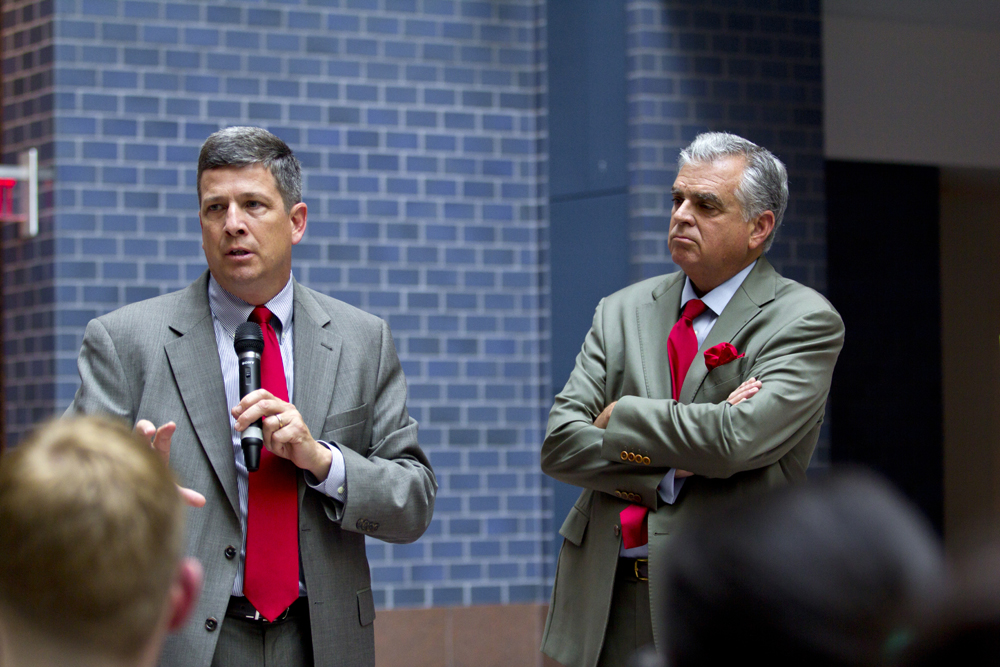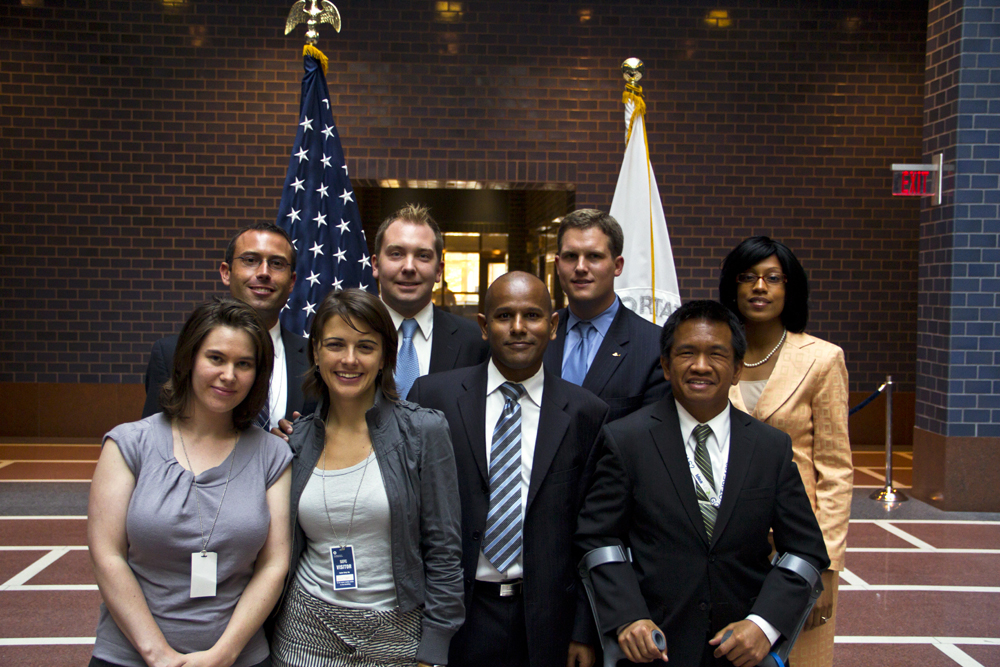
We are celebrating 15 years — and counting — of stories that are deeply researched and deeply felt, that build a historical record of what the city has been.
We are celebrating 15 years — and counting — of stories that are deeply researched and deeply felt, that build a historical record of what the city has been.
Last Wednesday, members of Young Professionals in Transportation (YPT) gathered at the US Department of Transportation (DOT) headquarters in Washington, DC to hear Transportation Secretary Ray LaHood and Deputy Secretary John D. Porcari speak on current transportation issues in the US and their intersection with politics. The DOT headquarters, a brownfield redevelopment of a former gun barrel manufacturing factory on the Anacostia waterfront, provided the backdrop for an hour-long exchange on transportation and economic recovery. The event, loosely titled “Leadership Seminar,” attracted a hundred or so YPT members working in transportation in both the public and private sectors. It was one of a series of networking and educational events held throughout the summer in Washington, DC, where YPT is based. Both Secretary LaHood and Deputy Secretary Porcari appeared at points to be preaching to the choir — an audience of transportation enthusiasts — but nonetheless they painted with broad brushstrokes an engaging, 30,000-foot view of the current transportation landscape.
Deputy Secretary Porcari began his talk with a theme driving much of political discourse today: economic recovery. Explaining the role of the Recovery Act in promoting jobs growth, Deputy Secretary Porcari stressed that the Recovery Act and grants programs such as Transportation Investment Generating Economic Recovery (TIGER) had “reestablished connections we had lost” between the federal government and local agencies. He pointed out that programs such as TIGER, which was the source of $83 million in funds for the first phase of Moynihan Station in New York City, and the recently announced Federal Transit Authority Livability Grants, which encourage local agencies to incorporate transportation improvements early into the planning process, provide direct funds to mayors and to local and regional governments to deliver transportation services to their communities. The TIGER program, which was allocated $1.5 billion in the Recovery Act, was conceived as a national competition to spotlight multi-modal solutions to drive economic recovery on the local scale. Deputy Secretary Porcari argued that these connections with municipal and local-level agencies through direct funding have been quietly shifting public perception away from the idea that the US DOT’s primary relationship is with State-level DOTs. His analysis suggested that metropolitan areas, municipalities and local communities have become incubators of transportation innovation with a broader impact on state- and national-level transportation initiatives.
The Deputy Secretary identified two factors that define an effective funding strategy: consistency and predictability, both of which are lacking in current policy. Due to reauthorization uncertainty and myopic strategies built around short-term budget and political cycles, many argue that the government lacks a systematic, long-term solution to transportation financing. While President Obama devoted one-third of the last State of the Union speech to infrastructure innovation, no specific funding sources have been identified for much of these proposals. A federal infrastructure bank is still in its gestational stages and a surface transportation bill is stalled while Congress remains mired in the deficit debate. Deputy Secretary Porcari, sharing President Obama’s affinity for letter grade self-evaluations, assigned the current federal financing policy a D-/F grade.
Deputy Secretary Porcari concluded his remarks with the observation that “transportation is fundamentally a generational challenge” and that high speed rail will be one way in which the current generation secures a legacy for subsequent generations. He emphasized that the government is not seeking to replace current infrastructure with high speed rail or prioritize it over other modes, but rather is responding to the demographic reality of 2050, when the US population is slated to increase by 100 million in largely urban or rapidly urbanizing areas.
Secretary LaHood reinforced the ideas set forth by Deputy Secretary Porcari and, as a mouthpiece for the administration on transportation issues, reiterated President Obama’s goal to provide 80% of all Americans access to high speed rail in the next 25 years. The idea that high speed rail is the future of transportation in the US has become highly politicized and hotly debated; three states — Wisconsin, Ohio and Florida — have already turned down federal funds for high speed rail. These funds have been redistributed to fifteen states and Amtrak, which has identified the NYC-DC corridor as an underutilized asset for which rail can serve commuters in the region.
Secretary LaHood drew a parallel between President Eisenhower’s implementation of the interstate highway system in the 1950s, considered to be one of the most massive public works projects in US history, and President Obama’s blueprint for high speed rail today. Secretary LaHood observed that there was no established funding mechanism for the interstate program when it was first authorized but the project still moved forward. Ultimately the federal government agreed to pay 90% of the required funds, reducing the amount required by individual states, because state governors were wary of increasing taxes. But with impending spending cuts by the federal government, especially in light of the current deficit, a largely federally-funded solution seems uncertain, if not unlikely.
Secretary LaHood envisions high speed rail as an infrastructure project that, despite current opposition, will eventually become an integral part of transportation in daily life. He stressed Deputy Secretary Porcari’s point that the future of transportation comes down to options and providing a growing population with more modes of transport from which to choose, whether this is through a streetcar system (manufactured in the United States, he noted) in a single metropolitan area or a high speed rail system connecting several areas. In discussing how high speed rail has become highly politicized, Secretary LaHood responded to an audience member’s question — “why are Republicans against high speed rail?” — by using himself as an example of a Republican who supports the initiative and citing that only three Republican governors have turned down high speed rail funds (thus far, it should be noted). He advised the audience not to be dissuaded by partisan politics and stated that transportation has always been a bipartisan issue, a viewpoint many are sure to challenge.
Secretary LaHood and Deputy Secretary Porcari were aligned in their message that Americans want high speed rail and that the DOT is seeking to “reconnect transportation to qualities that Americans hold dear,” such as economic growth and improved quality of life. The whirlwind hour-long synopsis of current transportation issues that was cohesive in message but scant on specifics concluded with the administration’s achievements in the past two years, including a $48 billion stimulus plan which has put 65,000 Americans to work on 15,000 projects. The elephant in the room during this analysis was the debt ceiling debate currently raging in Congress. The significant role that the federal government plays in funding local, state and regional projects cannot be discounted, but with the government’s long-term discretionary spending plan under scrutiny, transportation funds are specifically at stake. Moving forward, fare increases, taxes and the privatization of transportation projects may be some ways in which local and state agencies will have to make up for the shortfall in federal funds. While Congress continues to debate the debt ceiling, the future of transportation funding remains in limbo. However, both officials made it clear that infrastructure financing needs to be more than a short-term priority.
The views expressed here are those of the authors only and do not reflect the position of The Architectural League of New York.

